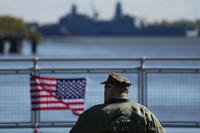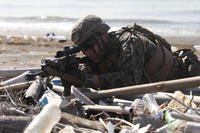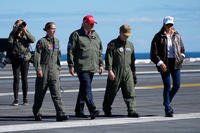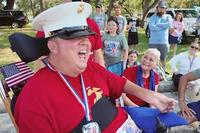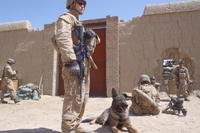The military magic act in trying to make the 30,000 troops of U.S. Army Europe (USAREUR) look like the 300,000 of the Cold War requires constant movement and results in constant logistics headaches for the 16th Sustainment Brigade posted in Baumholder, Germany.
There are the mismatched rail gauges, plus the mismatched gear, plus the growing heaps of red tape involved in crossing borders that the brigade has to overcome, Col. Michelle M.T. Letcher said last week at a briefing with her unit leaders at the Pentagon.
Take the nozzles, for instance. It may seem that the U.S. and its allies would have figured out a way by now to refuel each other's trucks after 66 years of working together in NATO, but such is not the case.
Capt. Nicholas Greco, commander of the 515th Transportation Company, went for the fix last October in Spain during the Trident Juncture exercise, NATO's largest in 10 years involving 36,000 troops from 30 countries.
"The thing is, there's no standard NATO logistics kind of brigade," Greco said at the roundtable briefing by the brigade leaders. "So it's a team effort when we come together. We don't all have the same standardized equipment, the same size hoses."
Greco said he and his troops took a couple of U.S. adaptors, a couple from the British set and a couple from the Spanish set, with the idea being "to push fuel from one bag form (Modular Combined Petroleum Unit) for the Italians, say, into a Polish truck. "We identified a lot of lessons learned and we found a couple of different adaptors we're working on purchasing and procuring now," Greco said.
In an Army release, Sgt. Arthur Kreft, one of Greco's troops in the 515th Transportation Company, said "We researched the fuel adaptors for months before the exercise to find the correct NATO adaptor so that we can now fuel almost any other country here."
Letcher echoed Lt. Gen. Hodges in putting Greco's problem in perspective. At the height of the Cold War, USAREUR had 300,000 troops in Europe and "now we're down to about 30,000. One of our missions is to kind of have the same effect but with less. So what we have to do is make 30,000 look and feel like 300,000. One way is to empower junior leaders."
A prime example of junior leader empowerment was the posting of a young sergeant from the 16th as the logistics advisor to Ambassador Jeffrey Levine at the U.S. Embassy in Tallinn, Estonia.
"In Estonia, we have a sergeant who sits in the embassy and advises the ambassador on freedom of movement and coordination in that country -- a very young leader in the U.S. Army with really a very strategic mission," Letcher said. "We don't have schools that prepare a sergeant to sit in embassies."
The overall mission of the brigade was "to deter Russian aggression," Letcher said, which means meeting Hodges' need for speed.
At a Pentagon news conference last month, Hodges said he had to keep his troops in constant motion to keep Russian President Vladimir Putin at bay.
"So, it really is about speed," Hodges said. Putin "has freedom of movement on interior lines because he's moving inside of Russia, whereas the alliance is moving across multiple sovereign borders. You know, how fast can you get soldiers and equipment, either by rail or road movement, to assemble somewhere?"
"So that means that we have to show up, units have to assemble on very short notice and plug in and be interoperable," Hodges said.
The rail movement can be problematic, said Lt. Col. Steven Dowgielewicz, commander of the 39th Transportation Battalion. "We always assume that it's a universal rail gauge and any rail car can ride on any rail track," he said.
But it doesn't work that way with some allies. Lithuania has a wide gauge and "you cannot put a German or Polish rail car onto a wide gauge track" to move gear into Lithuania or other former Soviet bloc countries, Dowgielewicz said. "We either have to trans-load the equipment or you have to change the wheels under the flatbed of the rail car so that you can continue moving that equipment," he said.
Despite the rail gauge problem, the 39th Transportation Battalion has managed to boost rail movements dramatically. In 2014, there were 33 rail movements by USAREUR and last year there were 233, Dowgielewicz said.
Then there's the red tape involved in border crossings, each of which requires a Transportation Movement Clearance form. "Last year, we processed over 23,000 of them -- that's 23,000 movements across the European theater," compared to 15,000 in 2013, Dowgielewicz said.
Letcher, a veteran of Iraq and Afghanistan, said that in a way it was easier to do her job in a war zone. "In Iraq and Afghanistan, you had freedom of movement," as opposed to the multiple boundaries, multiple languages and multiple currencies in Europe, she said.
Letcher's 2,200 troops have responsibility for supply and distribution for USAREUR from Bulgaria on the Black Sea to Estonia on the Baltic Sea. In addition to backing up USAREUR, the brigade also has supply and distribution responsibilities for Africa Command and, on occasion, for U.S. Central Command.
"Right now we are able to fulfill the missions we are asked to do," but it involves a lot of improvising. Letcher noted that in Afghanistan there were three sustainment brigades. In Europe, she has one.
--Richard Sisk can be reached at Richard.Sisk@Military.com.


